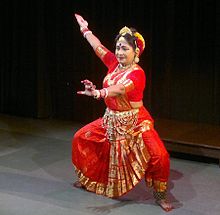Gaudiya Nritya
 Gaudiya dance | |
| Native name | গৌড়ীয় (Bengali) |
|---|---|
| Instrument(s) | Anaddha, Ghana, Susir and Tata[1] |
| Origin | West Bengali, India |


Gaudiya Nritya (Bengali: গৌড়ীয় নৃত্য, IAST: Gaur̤īẏa Nṛtya) or Gour̤īyo Nrityo, is an ancient Bengali classical dance tradition.[2][3][4] It originates from Gauda, also known as Gaur, in Bengal.
It has been reconstructed by Mahua Mukherjee.[4][5] It is recognised as an Indian classical dance by Ministry of Culture,[6] also recognized by Sangeet Natak Akademi ,but study of it is eligible for scholarships from the Ministry of Culture of India.[7] Scholarly reception of the reconstruction ranges from caution to skepticism.[8][9][10][11]
Etymology
On 21 September 1994, The name Gaudiya Nritya was adopted on the advice of Indologist Bratindra Nath Mukhopadhyay.[12] Reasons for this designation include: in ancient times – the reign of Shashanka and the Pala and Sena eras – the whole of Bengal was referred to as Gauda and the presence of the Gaudiya style in the Indian music and literature. Also, in the fifteenth century, Sangeet Shastrakar Maheswara Mohapatra of Odisha mentions seven types of dance styles in Abhinaya Chandrika, including Gaudiya dance.[13]
References
- ^ Mukherjee 2000, p. 95.
- ^ Roma Chatterji (2005). Folklore and the Construction of National Tradition Archived February 12, 2018, at the Wayback Machine. Indian Folklife 19 (Folklore Abroad: On the Diffusion and Revision of Sociocultural Categories): 9. Accessed January 2014. "a classical dance tradition that has vanished from the urban areas".
- ^ "West Bengal Tourism: Dance". Department of Tourism, Government of West Bengal. 2011. Archived from the original on October 21, 2013. Retrieved January 11, 2014.
- ^ a b Bharatram, Kumudha (April 9, 2011). "Dance of the ancients". The Hindu. Retrieved November 15, 2013.
- ^ Rajan, Anjana (December 26, 2006). "The wheel has come full circle". The Hindu. Archived from the original on November 8, 2012.
- ^ "Gaudiya Nritya". INDIAN CULTURE. Retrieved January 25, 2022.
- ^ "Scholarship to Young Artistes, 2005". Ministry of Culture. Government of India. Archived from the original on October 21, 2013.
- ^ "Feet forgotten and found". www.telegraphindia.com. Retrieved January 25, 2022.
- ^ Utpal Kumar Banerjee (2006). Indian performing arts: a mosaic. New Delhi: Harman Publishing House. ISBN 9788186622759. p. 79: "re-creating Gaudiya Nritya as one of the acceptable classical styles will need a formal framework".
- ^ Leela Venkataraman (2006). Negotiating the Extremes: dance. India International Centre Quarterly, 33 (1): 93-102. (subscription required) "one may have reservations about the classical dance repertoire visualised by [Mukherjee]".
- ^ Roma Chatterji (2005). p. 9: "Mukherjee tries to reconstitute a Bengali aesthetic within the perspective of pan-Indian civilisation".
- ^ Mukherjee 2000, p. 1.
- ^ Mukherjee 2000, pp. 1–2.
Bibliography
- Sengupta, Pallab; Banerjee, Manabendu; Mukherjee, Mahua, eds. (December 2005). Gaudiya Dance: A Coolection of Seminar Papers. 1 Park Street, Kolkata: The Asiatic Society.
{cite book}: CS1 maint: location (link) - Mukherjee, Mahua (January 2000). Gaur̤īẏa Nṛtya গৌড়ীয় নৃত্য [Gaudiya Dance] (in Bengali). 1 Park Street, Kolkata: The Asiatic Society.
{cite book}: CS1 maint: location (link)
External links
![]() Media related to Gaudiya Nritya at Wikimedia Commons
Media related to Gaudiya Nritya at Wikimedia Commons

